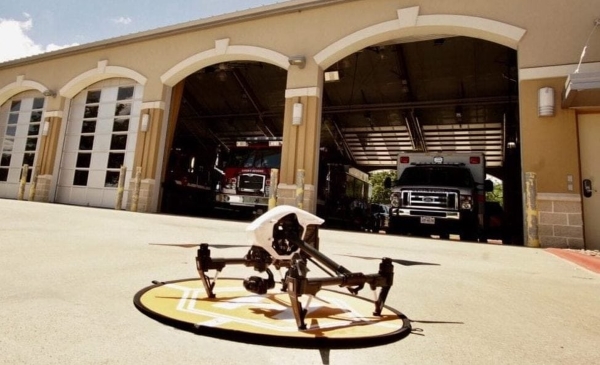[This story from VentureBeat is about valuable applications of aerial telepresence; more details are on the Cape website and in coverage in Aviation Today, which includes this:
“The U.S. government launched the [drone integration pilot program] because drones are a quickly expanding industry. Civilians and companies alike are embracing them and finding new uses every day. [Cape CEO] Rittler is confident that we’re on the cusp of a broader integration into the fabric of society. ‘I really think we’re at that point, kind of like when the smartphone first came out, everybody said ‘This will never be used in enterprise,’ he said. ‘And all of a sudden, it became the enterprise tool, and everybody was creating mobile enterprise applications and mobile enterprise extensions. I think we’re right there at the end of that curve as well.’”
–Matthew]

[Image: A Cape-equipped drone in front of the Ensenada, Mexico fire department.]
San Diego Fire Department to test remotely piloted drones as part of FAA program
Khari Johnson
August 10, 2018
The San Diego Fire Department (SDFD) today began tests of camera-equipped drones to help fight fires. Firefighters on the ground will deploy the drones, but once they’re in the air, the drones will be controlled by trained drone pilots using the Cape telepresence drone platform, a company spokesperson told VentureBeat in an email.
Once the drones receive regulatory approval, they can take flight in emergency response to give an overhead view of fires, identify people or hot spots with thermal sensors, and supply information that helps public safety officials make informed decisions in order to develop a plan of action before fire trucks can reach the scene.
Cape supplies telepresence capabilities to drone operators in various parts of the world so that trained drone pilots don’t have to physically be on the scene to do their jobs, an approach that can save time and expand viable use cases for a drone.
Drones have been deployed by dozens of fire departments across the United States, including some currently taking part in the fight against the biggest wildfires in the history of the state of California, but the SDFD deployment is different.
The Cape-SDFD partners is one of the first in a series of experiments as part of the Federal Aviation Administration’s (FAA) unmanned aerial systems integration pilot program, a project just beginning to explore transformative future use cases for drones.
In May, the FAA chose 10 applicants from a pool of more than 160 applications by local or regional governments across the country interested in reimagining how drones can be used by governments and private industry.
The results of the pilot program could help reform government policy to allow things like drone deliveries over homes and reshape how airspace is used in the United States.
In addition to Cape’s work, UC San Diego Health will use the pilot program for delivering blood products and medicine, and Uber Eats will use it to test out food deliveries. Companies like Qualcomm and AT&T will also play a part in the pilot program to do things like deploy 5G test networks and FirstNet, AT&T’s national first responder network.
In other parts of the U.S., the program will be used to explore things like nighttime flight, aircraft inspection, package deliveries, and even mosquito control in Ft. Myers, Florida.
Though some projects chosen to participate in the pilot program are within metropolitan areas like Memphis, Tennessee or Raleigh, North Carolina, most are in small towns, and San Diego is by far the largest city chosen to take part in the program.
Cape sees opportunities for drone telepresence for farmers, and maintenance for telecommunication and oil and gas companies, but views public safety as a major potential application of its technology. The company is also working with the Chula Vista Police Department, and south of San Diego in Ensenada, Mexico, police are using Cape to deploy a drone in emergencies.
“What we’re seeing is once they [police and fire] get ahold of Cape technology, it opens up new standard operating procedures,” Cape CEO Chris Rittler told VentureBeat in a phone interview. “When they get dispatched, now a drone is dispatched as part of that, and that’s game changing for them because they now have eyes in the air. And it changes their response time, and they can decide if it really needs a response as well, so that’s a significant application.”
At this time, police using Cape are not deploying forms of computer vision such as facial recognition or object detection; however, Cape does offer technology for tracking a suspect.
Rittler calls San Diego a great place to test drone applications because it’s such a busy airspace
San Diego simultaneously has: the busiest single-runway airport in the United States; Department of Homeland Security aircraft; one of the busiest commercial airports in the United States; and multiple Navy and Marines air stations. For example, Naval Outlying Landing Field Imperial Beach, near the U.S.-Mexico border, is one of the busiest helicopter training facilities on the West Coast of the United States.
Since Cape created its telepresence flight system, its operators have completed about 100,000 drone flights without incident, the company told VentureBeat in a statement.
Cape isn’t the only company equipping vehicles with telepresence capabilities. Robomart, an Alameda, California-based startup, plans to begin trials for its grocery store on wheels in the San Francisco Bay Area this fall using telepresence-controlled vehicles rather than an autonomous driving system.